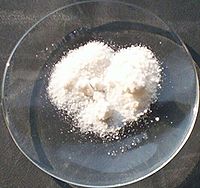
Photo from wikipedia
In recent years, both cation [1]and anion channels [2,3] have emerged as significant molecules with aberrant expression, activity, and localization in various pathological conditions such as cardiovascular dysfunction, neurological disorders,… Click to show full abstract
In recent years, both cation [1]and anion channels [2,3] have emerged as significant molecules with aberrant expression, activity, and localization in various pathological conditions such as cardiovascular dysfunction, neurological disorders, metabolic diseases, and cancers. The main class of anion channels associated with multiple pathological disorders are chloride channels. Chloride channels are widely present in the cell membranes and organelle membranes of organisms. The chloride channels can transport not only Cl but also I, Br, F, NO3, PO4 and even negatively charged amino acids, so some people called it anion channel. All the known chloride channels can be classified as members of the voltage-sensitive CLC subfamily, ligand-gated chloride channels such asγaminobutyric acid (GABA), and glycine receptors, calcium-activated chloride channels such as TMEM16A [4], high conductance chloride channels, the cystic fibrosis transmembrane conductance regulator (CFTR), and volume-regulated channels [5]. The opening of the chloride channel is related to membrane voltage, intracellular ATP hydrolysis, cell expansion, intracellular H, Ca concentration, intracellular residue phosphorylation, and cell signaling molecule binding. Chloride channels are involved in a wide range of biological functions, including stabilization of cell membrane potential, maintenance of intracellular pH, cell proliferation, fluid secretion, regulation of cell volume, and acidification of intracellular organelles [5]. Mutations in several chloride channels cause human diseases, including cystic fibrosis, macular degeneration, myotonia, kidney stones, renal salt wasting, and hyperekplexia. Chloride channel modulators have potential applications in the treatment of some of these disorders, as well as in secretory diarrheas, polycystic kidney disease, osteoporosis, and hypertension. A bibliometric study can calculate the productivity of institutions, countries, authors, and the frequency of keywords to explore research hotspots/frontiers in specific fields [6,7]. Through bibliometric analysis, researchers can summarize the current situation and development trends of research fields or specific diseases, and provide directions and ideas for future research [8]. CiteSpace and VOSviewer are the commonly used bibliometric visualization tools for data analysis and visualization [9,10]. Although chloride channels have been a hotspot of multidisciplinary research for decades, no bibliometric studies regarding the trends in chloride channel research activity have been published. Here, we collected scientific publications on chloride channel research in the past 16 years, using bibliometrics and visual analysis to explore the hotspots and frontier directions of chloride channel research and hope to provide researchers with some useful guidance. The data search was conducted on 25 June 2020. The retrieved data were collected within one day to avoid any potential deviation due to the daily
Journal Title: Channels
Year Published: 2020
Link to full text (if available)
Share on Social Media: Sign Up to like & get
recommendations!